MultipleChoice Questions 1 If P 1000 2Q a MR 1000Q 4 b M
Multiple-Choice Questions
1. If P = $1,000 - $2Q:
a. MR = $1,000Q - $4.
b. MR = $1,000 - $8Q.
c. MR = $1,000 - $4Q.
d. MR = $250 - $0.25P.
2. Total cost minimization occurs at the point where:
a. Q = 0.
b. MC = AC.
c. AC = 0.
d. MC = 0.
3. Average cost minimization occurs at the point where:
a. MC = AC.
b. MC = 0.
c. AC = 0.
d. Q = 0.
4. When the product demand curve is Q = 140 – 10P, and price is decreased from P1 = $10 to P2 = $9, the arc price elasticity of demand is:
a. -10
b. -3
c. -4
d. -2.1
5. If the point price elasticity of demand equals -2 and the marginal cost per unit is $10, the optimal price is:
a. $5
b. $10
c. $20
d. impossible to determine without further information.
6. When the cross-price elasticity :
a. demand rises by 3% with a 1% increase in the price of X.
b. the quantity demanded decreases by 3% with a 1% increase in the price of X.
c. the quantity demanded rises by 1% with a 3% increase in the price of X.
d. demand decreases by 3% with a 1% increase in the price of X.
7. If and MC = $0.44, the profit-maximizing price is:
a. 3
b. $0.99
c. $0.66
d. $1.98
8. When the product demand curve is P = $5 - $0.05Q, and Q = 60, the point price elasticity of demand is:
a. -2/3
b. -3/2
c. -8/3
d. -3/8
Use the following table to answer the next question. The Uretown Yokels ice hockey team is the only live sports entertainment in Uretown.
Ticket Price Total Attendance Total Revenue Marginal Revenue
$14 100 $1400
$12 200 $2400 $10
$10 300 $3000 $6
$8 400 $3200 $2
$6 500 $3000 -$2
$4 600 $2400 -$6
9. At a price of $8 per ticket, the Yokels attract 400 spectators. For the Yokels to attract 500 spectators, they would have to ______________ price. Total revenue would ________________ .
a. increase; increase b. increase; decrease c. decrease; increase d. decrease; decrease
10. The production function Q = 0.25X0.5 Y0.5 exhibits:
a. constant returns to scale.
b. increasing returns to scale.
c. increasing and then diminishing returns to scale.
d. diminishing returns to scale.
11. When PX = $60, MPX = 2 and MPY = 2, relative employment levels are optimal provided:
a. PY = 16.7¢.
b. PY = $24.
c. PY = $60.
d. PY = $150.
12. When PX = $100, MPX = 20 and MRQ = $5, the marginal revenue product of X equals:
a. $100.
b. $50.
c. $10.
d. $5.
13. If total product for each of five units of labor is 10, 16, 20, 30, and 34, respectively, the marginal product of the third unit is
a.
20
b.
10
c.
4
d.
0
14. If P = $8 and MC = $5 + Q, the competitive firm\'s profit-maximizing level of output is:
a.
3
b.
0.2
c.
8
d.
15
15. If fixed cost at Q = 100 is $130, then
a.
fixed cost at Q = 0 is $0
b.
fixed cost at Q = 0 is less than $130
c.
fixed cost at Q = 200 is $260
d.
fixed cost at Q = 200 is $130
16. If variable cost rises from $60 to $100 as output increases from 15 to 20 units, the marginal cost of the twentieth unit
a.
is $100
b.
is $5
c.
is $40
d.
is $8
17. Suppose Guild produces 5,000 guitars per year. Its average total cost is $90, and its fixed cost is $250,000. What is its variable cost?
a.
$250,000
b.
$450,000
c.
$25,000
d.
$200,000
18. If an increase in the price of a product from $1 to $2 per unit leads to a decrease in the quantity demanded from 100 to 80 units, then the value of price elasticity of demand is
a.
-1/3
b.
-2 1/3
c.
-1/4
d.
-3
19. So long as P > AVC, the competitive firm\'s short-run supply curve is equal to:
a.
AVC
b.
MC
c.
P
d.
none of these.
20. At the profit maximizing level of output for a monopolist:
a.
P = AR and AR = AC
b.
P > MC and MR = MC
c.
P = MC and MR > MC
d.
P = MR and AC = MC
21. Holding supply conditions constant, the costs of regulation fall wholly on producers when:
a.
EP = 1
b.
EP => 1
c.
EP =
d.
EP = 0
22. A 100% markup on cost is equivalent to a markup on price of:
a.
25%
b.
33%
c.
50%
d.
100%
23. A 25% markup on price is equivalent to a markup on cost of:
a.
25%
b.
33%
c.
50%
d.
100%
24. When EP = -3, the optimal markup on cost is:
a.
100%
b.
67%
c.
50%
d.
33%
25. When EP = -2, the optimal markup on price is:
a.
100%
b.
67%
c.
50%
d.
33%
Use the following table to answer the next question
Quantity
of output
Total
cost
0
$ 50
10
85
20
150
30
220
40
305
50
455
26. If the market price is $8.50, what are the profit-maximizing output and profit?
a.
output = 40; profit = $35
b.
output = 40; profit = $0
c.
output = 0; profit = -$50
d.
output and profit cannot be determined because marginal revenue cannot be calculated
27. If a firm charges a price of $6 for a product with a cost of $5, the markup on cost equals:
a.
67%
b.
33%
c.
20%
d.
50%
28. If a firm charges a price of $5 for a product with a cost of $3, the markup on price equals:
a.
60%
b.
150%
c.
250%
d.
40%
29. If the optimal markup on price is 50%, the optimal markup on cost is:
a.
100%
b.
75%
c.
50%
d.
25%
30. If the optimal markup on cost is 25%, the optimal markup on price is:
a.
20%
b.
25%
c.
50%
d.
100%
31. The competitive market pricing rule-of-thumb for profit maximization is to set:
a.
MR > MC
b.
MR = MC
c.
P = MC/[1 + (1/EP)]
d.
MC = MR/[1 + (1/EP)]
32. What is the Herfindahl-Hirschman Index (HHI) for an industry in which five firms each control 20% of the market?
a. 20; b. 100; c. 2,000; d. 5,000
33. Which of the following pieces of antitrust legislation banned tying contracts, limited mergers, and banned price discrimination?
a. The Sherman Act. b. The Wheeler-Lea Act. c. The Clayton Act.
d. The same legislation that created the Interstate Commerce Commission (ICC).
34. Refer to the figure below. How much profit does the profit-maximizing monopoly earn?
a. $0; b. $6,000; c. $5,040; d. $10; e. $960
35. Refer to the figure below. From the structure of cost and revenue of the firm, we would predict that this monopoly will:
a. Shut down in the short run, and go out of business in the long run.
b. Shut down in the short run, but continue to operate in the long run.
c. Operate in the short run, but go out of business in the long run.
d. Operate
36. Refer to the figure below. How much is consumer surplus in the monopoly outcome?
a. Area C; b. Area R; c. Area D; d. Area C + D; e. Area C + R + D
37. Refer to the figure below. To maximize profit, what price should the firm charge?
a. $18; b. $15; c. $8; d. $4
38. Refer to the figure below. The firm in question exhibits economies of scale:
a. Along the decreasing portion of the long-run average cost curve (LRAC), up until Q0.
b. Along the increasing portion of the long-run average cost curve (LRAC), after Q0.
c. At Q0, where LRAC is minimum.
d. Anywhere along the LRAC, as long as increasing the scale of operations does not affect cost per unit.
Use the following table, which provides long-run information about the market for apples, to answer the next two questions. Price is price per pound of apples.
Quantity Price Marginal Marginal Average (pounds) per Pound Revenue Cost Total Cost
100 $1.40 -- -- $2.00
200 $1.07 $0.74 $0.50 $1.50
300 $0.92 $0.62 $0.46 $0.75
400 $0.80 $0.44 $0.44 $0.70
500 $0.66 $0.10 $0.43 $0.65
600 $0.50 - $0.30 $0.50 $0.50
700 $0.30 - $0.80 $0.59 $1.00
39. Given the cost information above, a monopoly would charge a price of ______________ per pound and produce ________________ pounds of apples.
(a) $0.80; 400 (b) $0.44; 400 (c) $0.50; 600 (d) $0.30; 600
40. Given the cost information above, a perfectly competitive industry would charge a price of ______________ per pound and produce ________________ pounds of apples.
(a) $0.80; 400 (b) $0.44; 400 (c) $0.50; 600 (d) $0.30; 600
| a. | 20 |
| b. | 10 |
| c. | 4 |
| d. | 0 |
Solution
1. Option C is thr right answer. If we differentiate p with the aid of power rule we will get this equation.
2.Marginal cost curve will cut average cost curve at this minimum point, which shows that at this minimum point MC=AC
3. Average cost will also be minimum at this point only. Because it is the minimum point in the graph
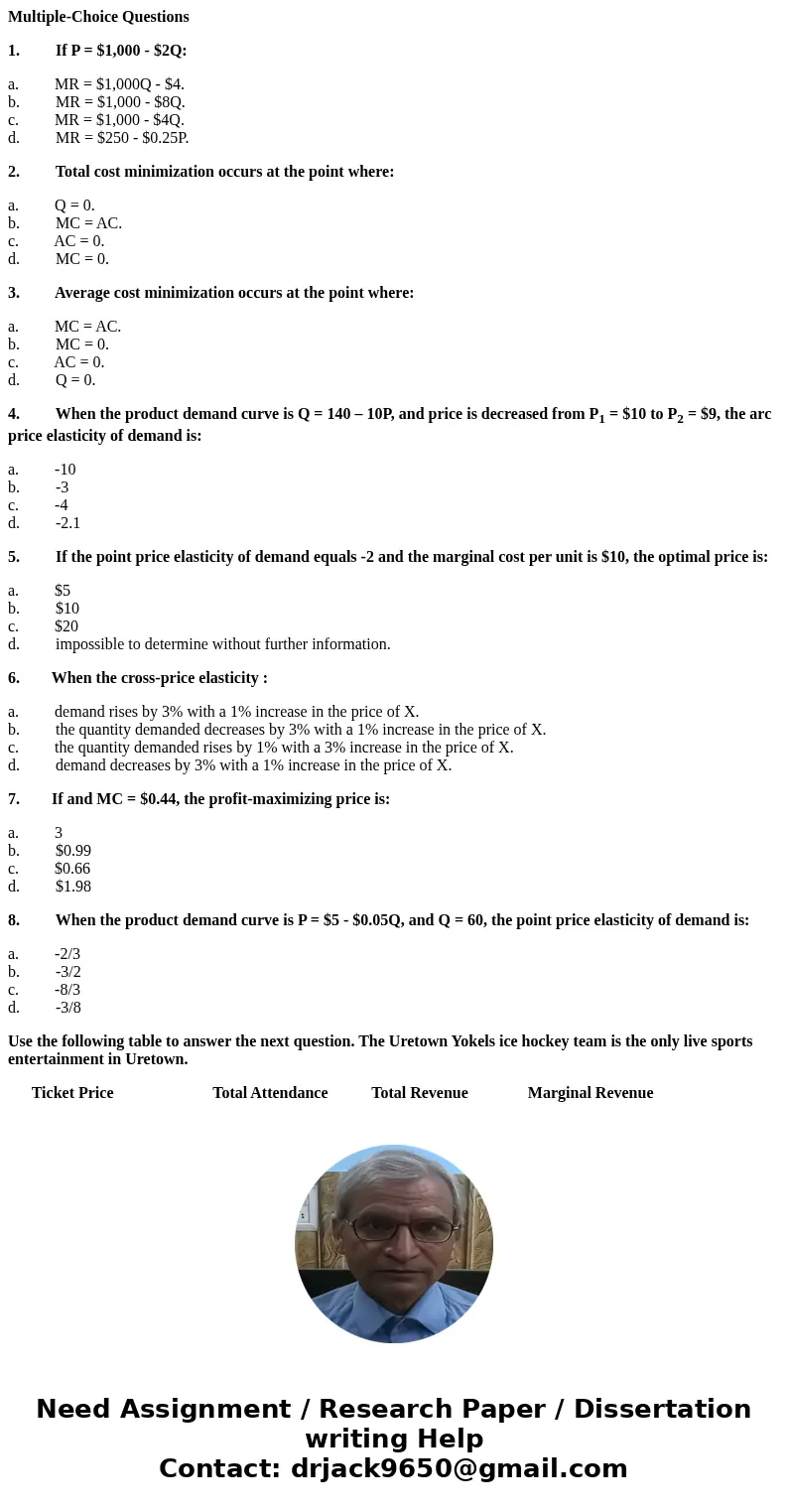
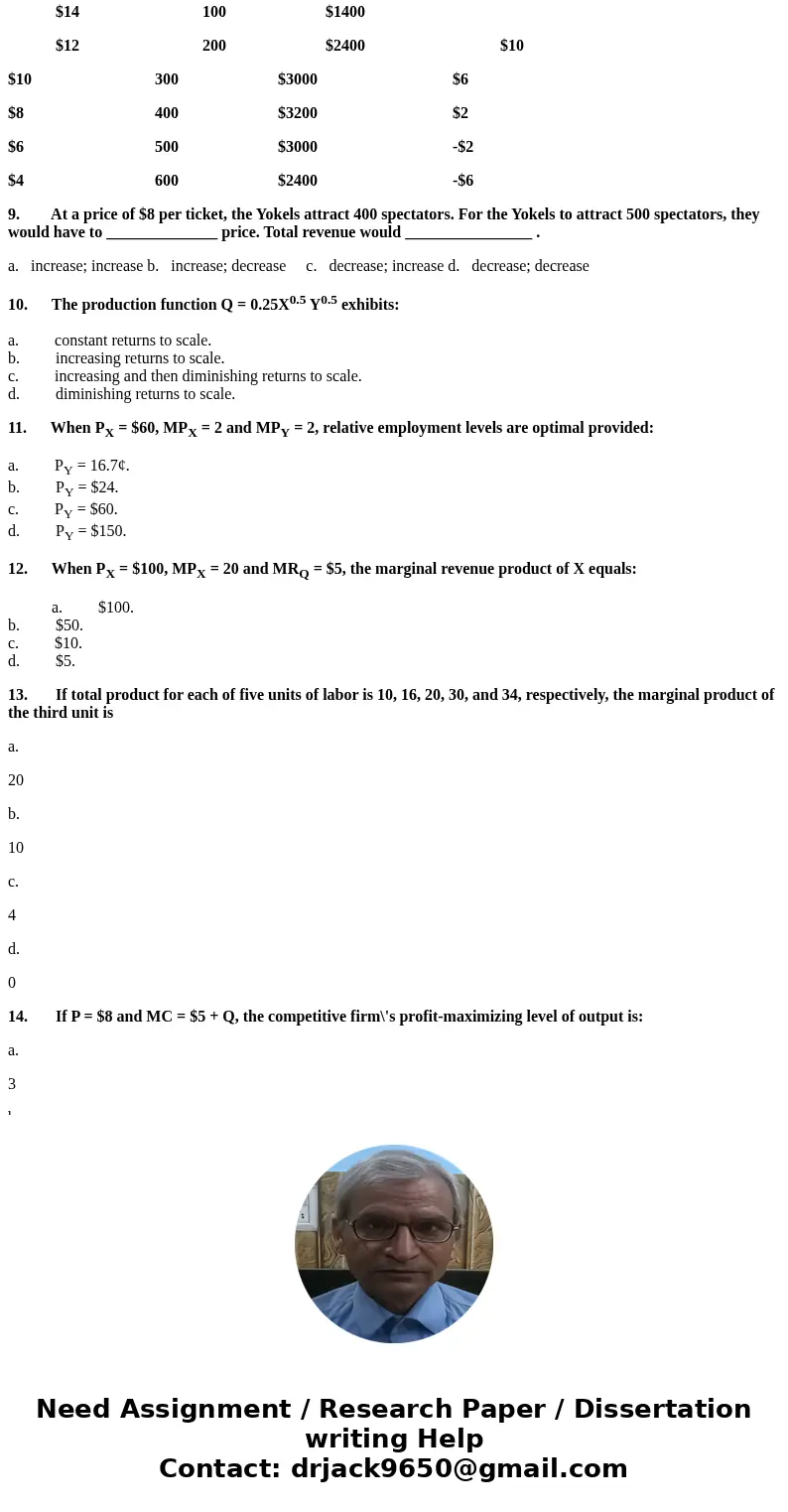
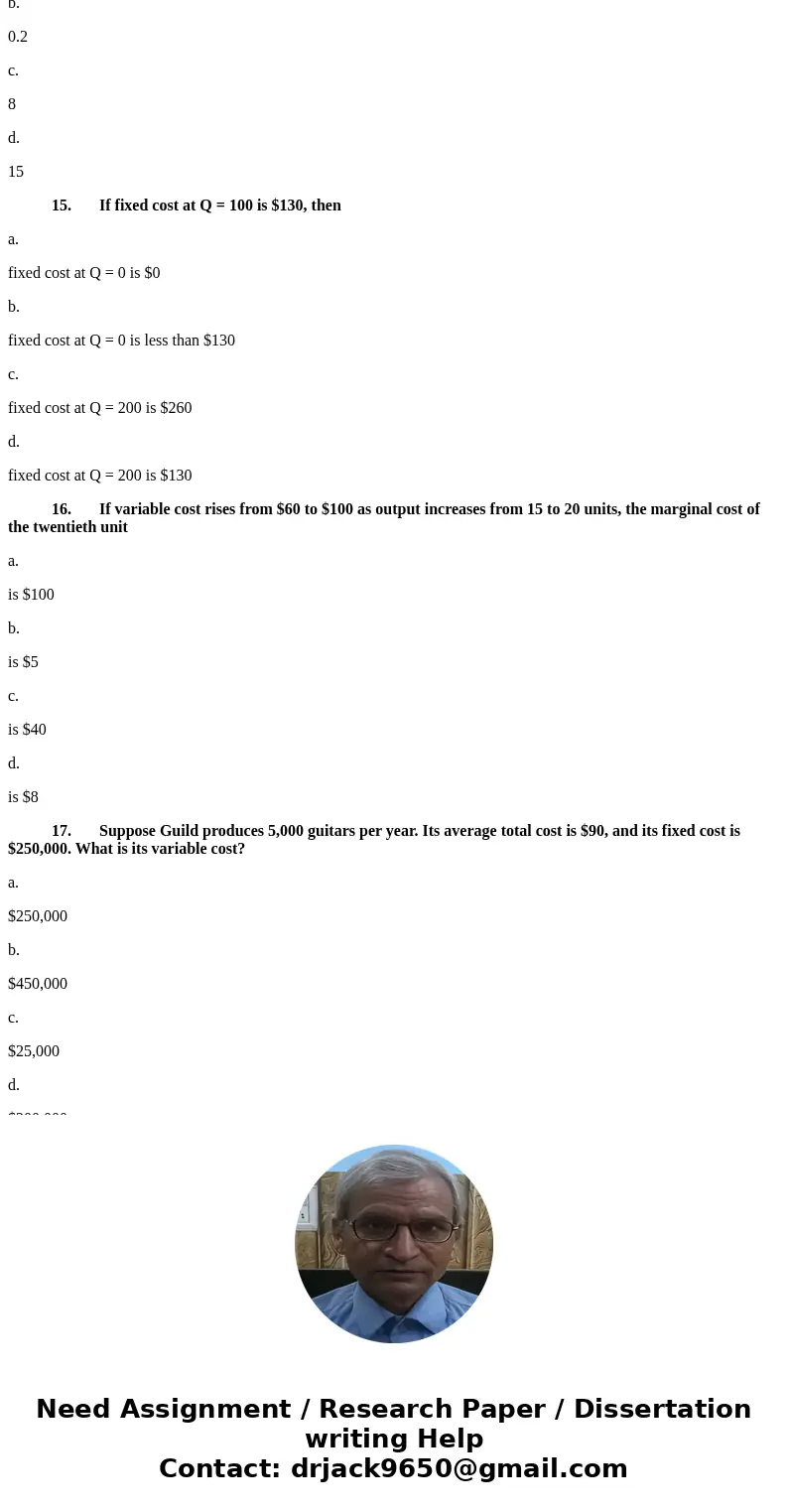
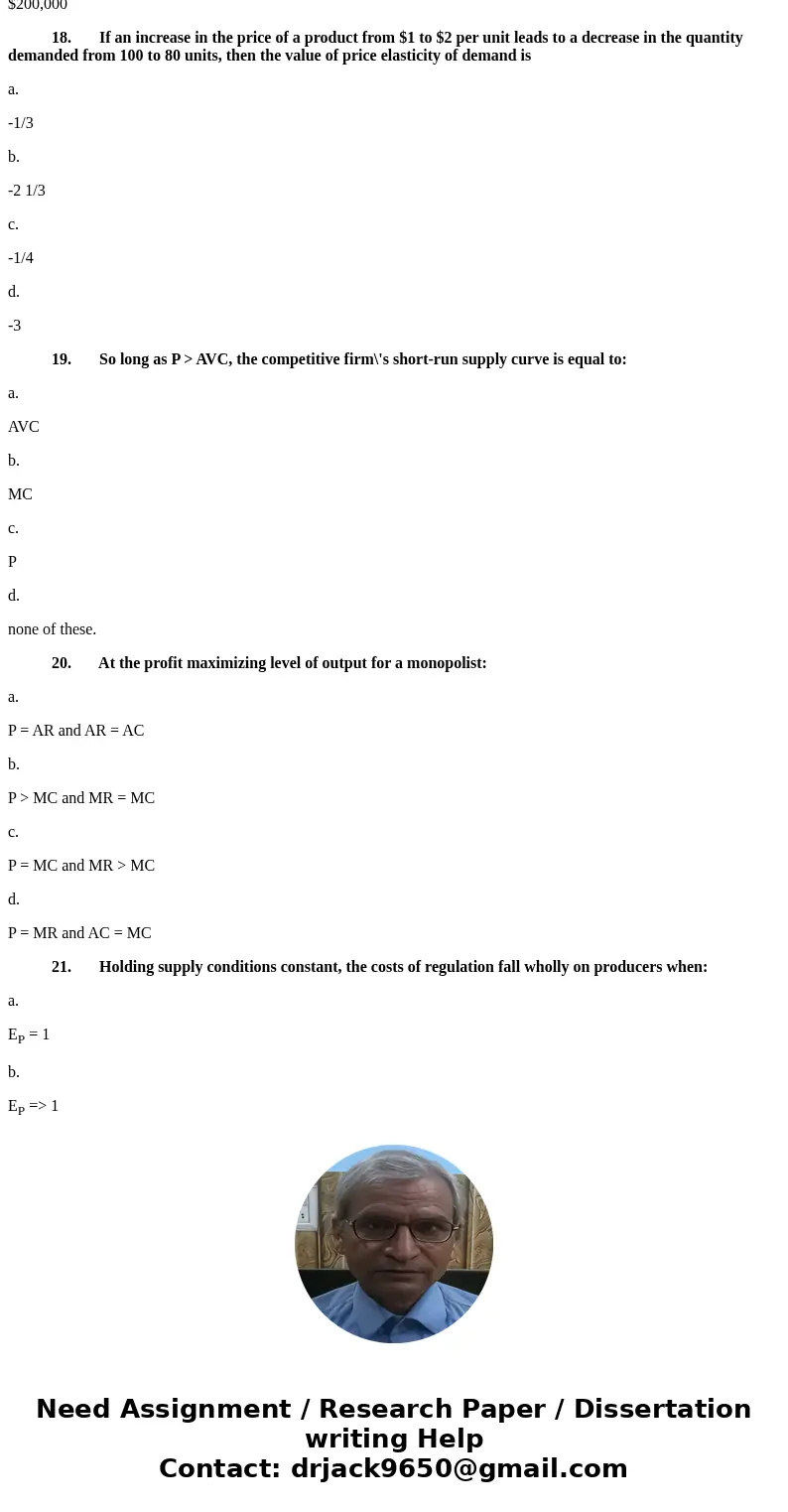
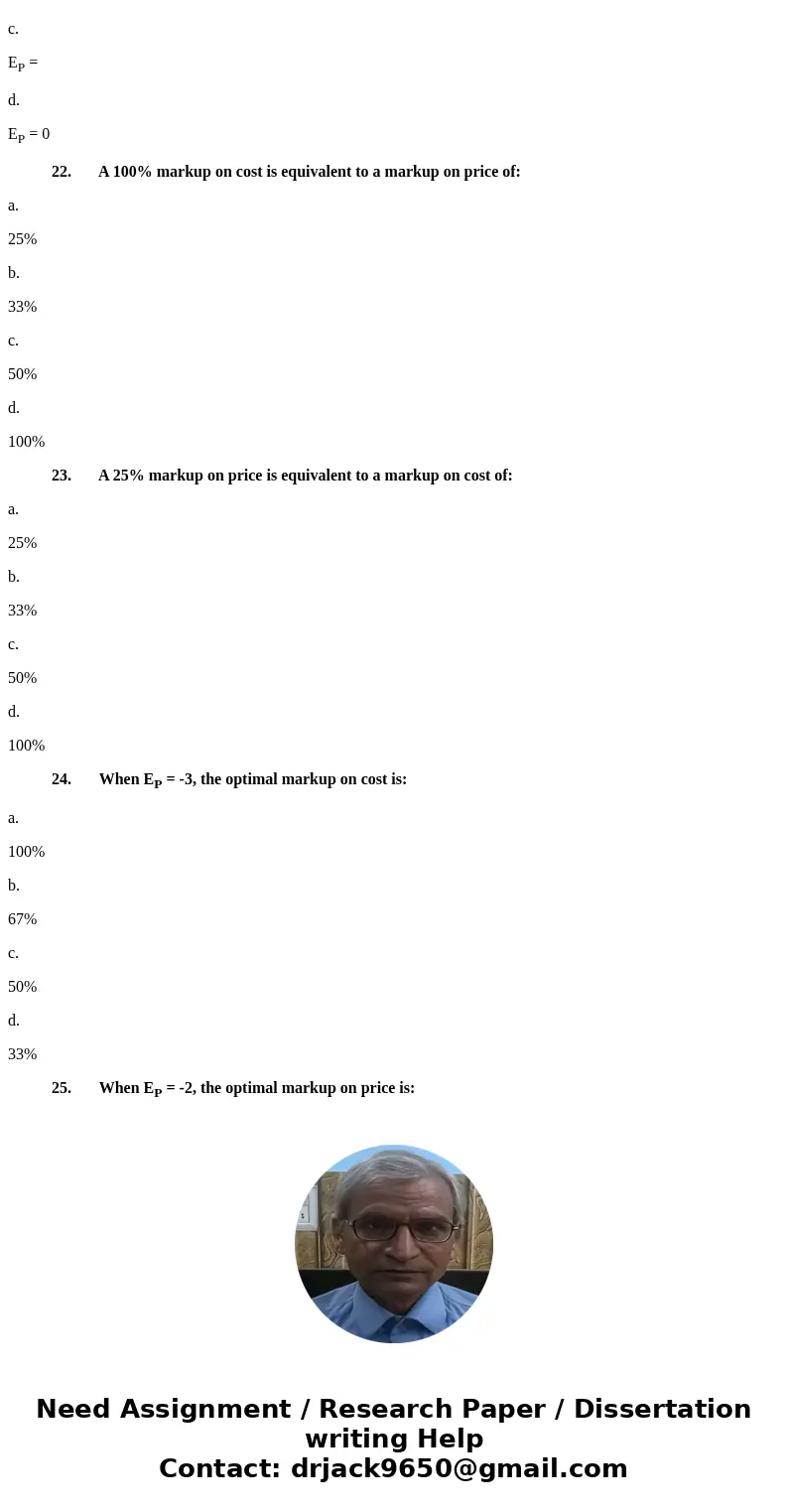
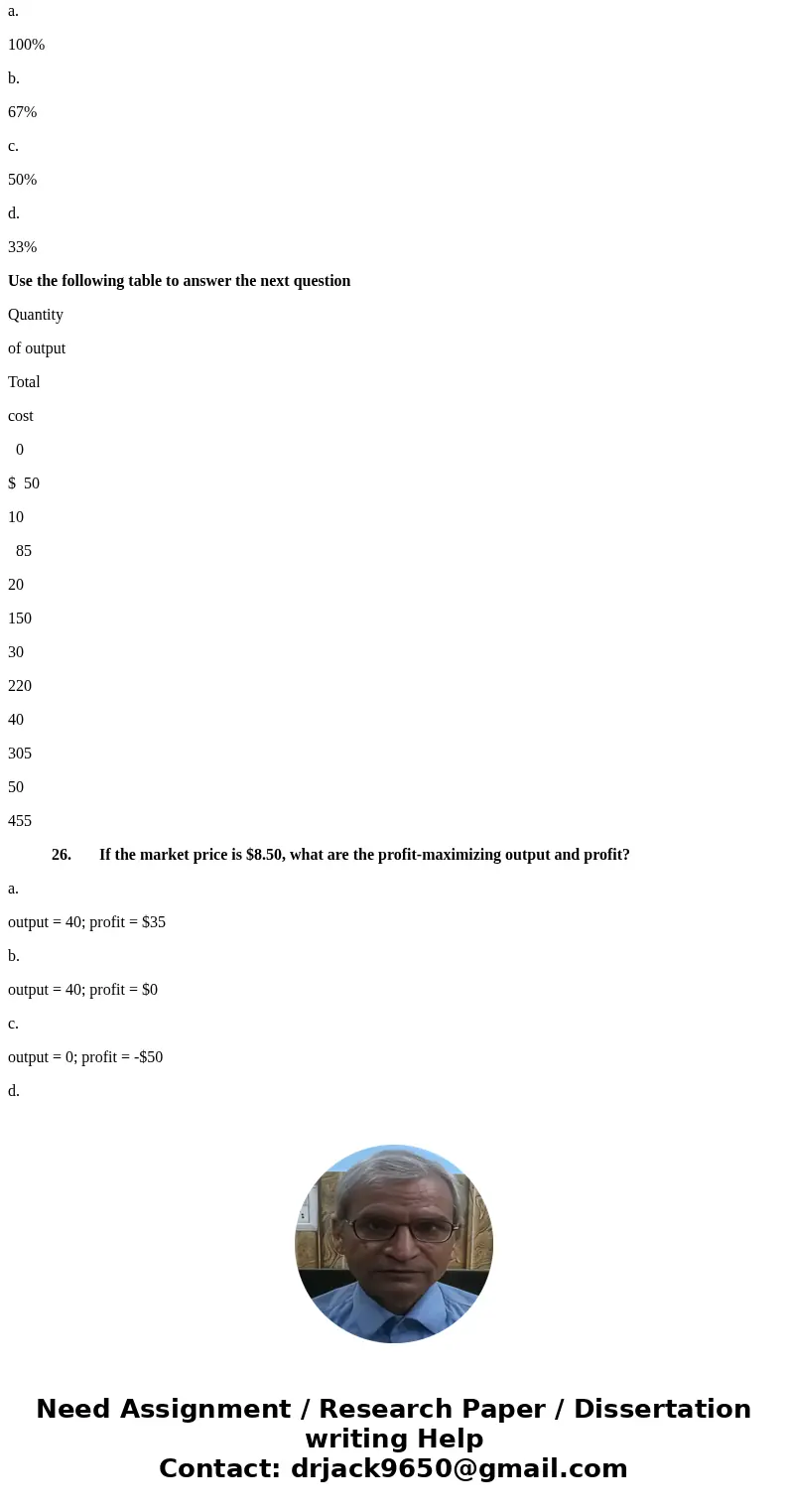
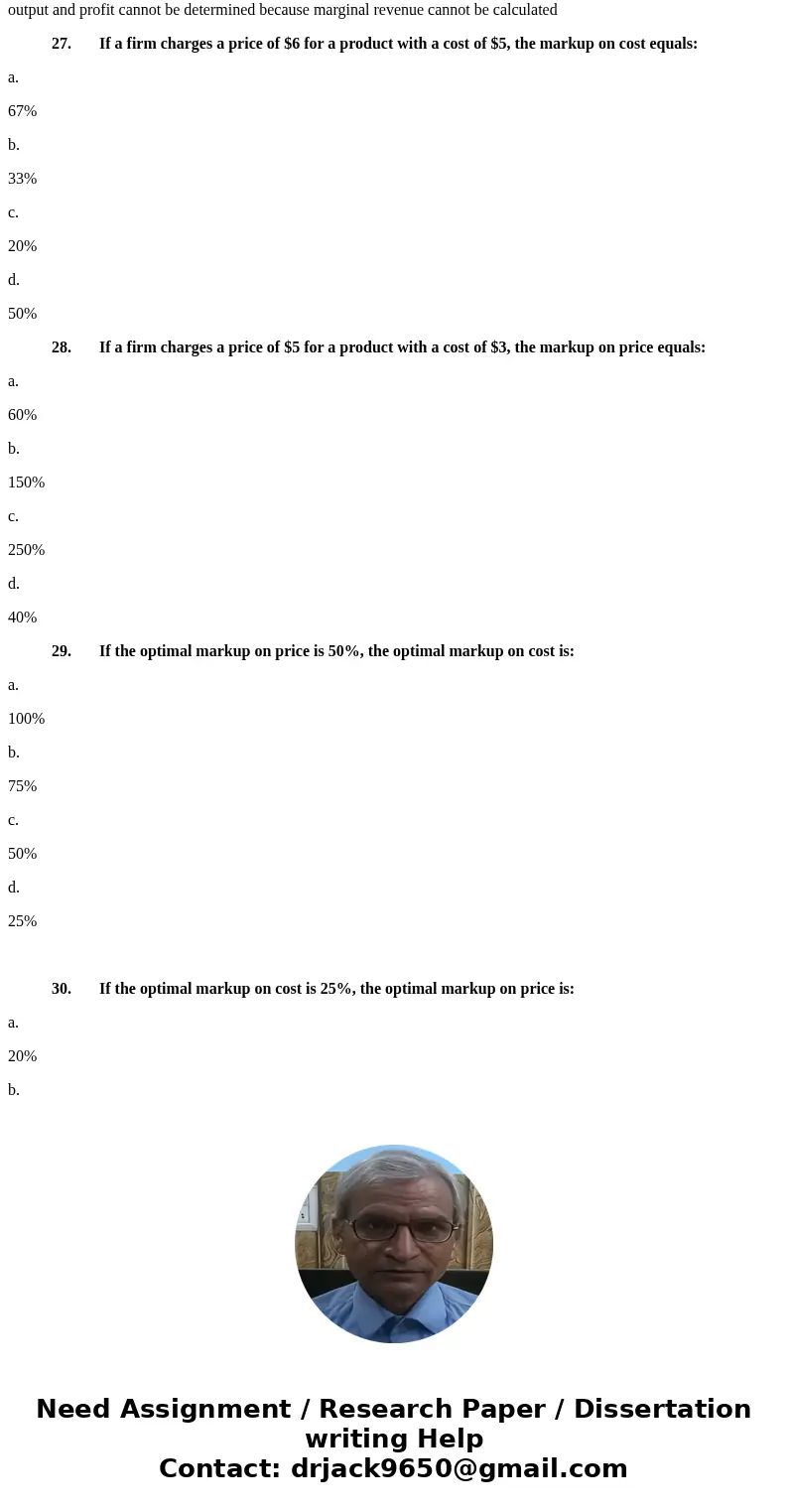
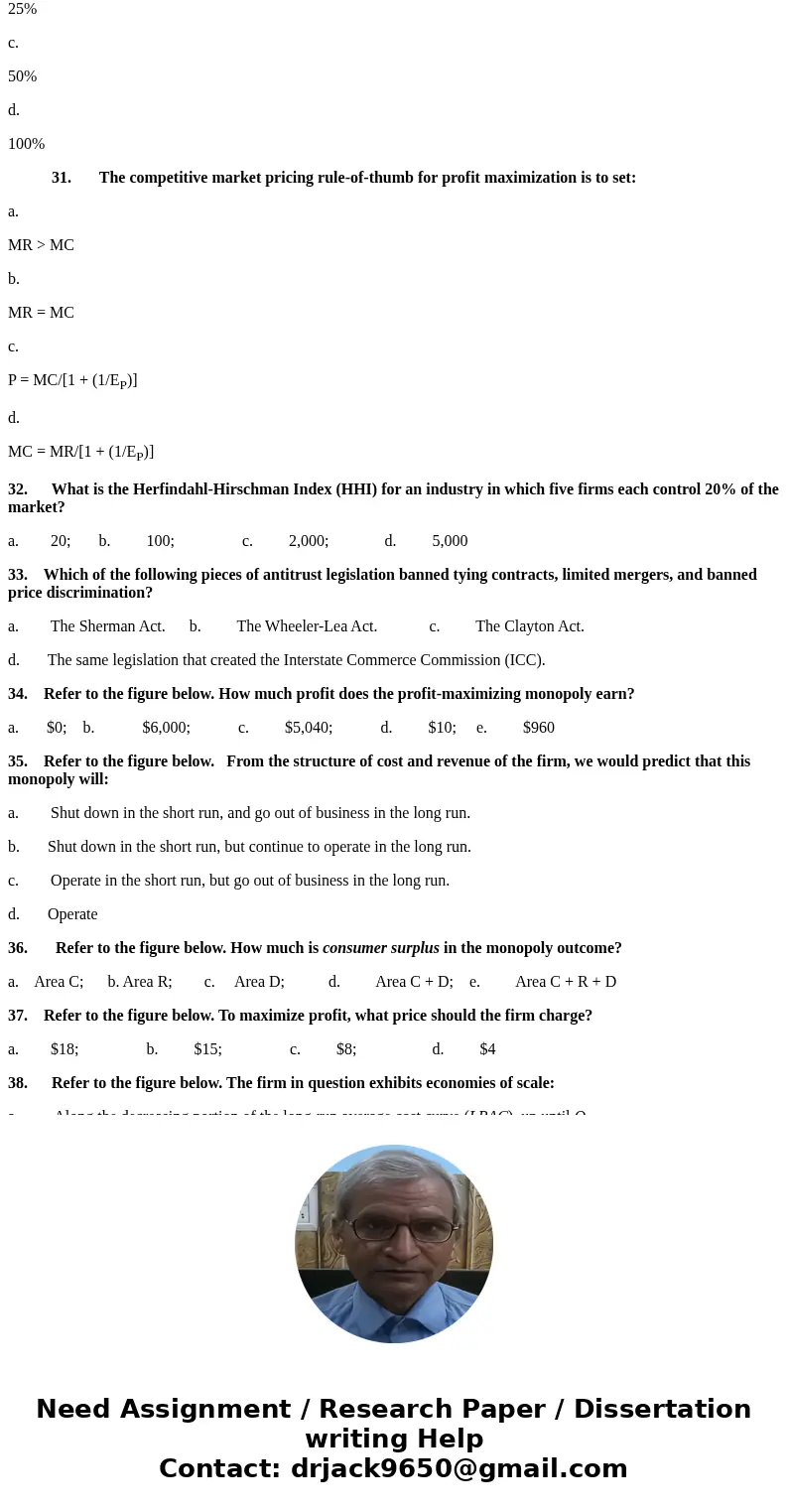
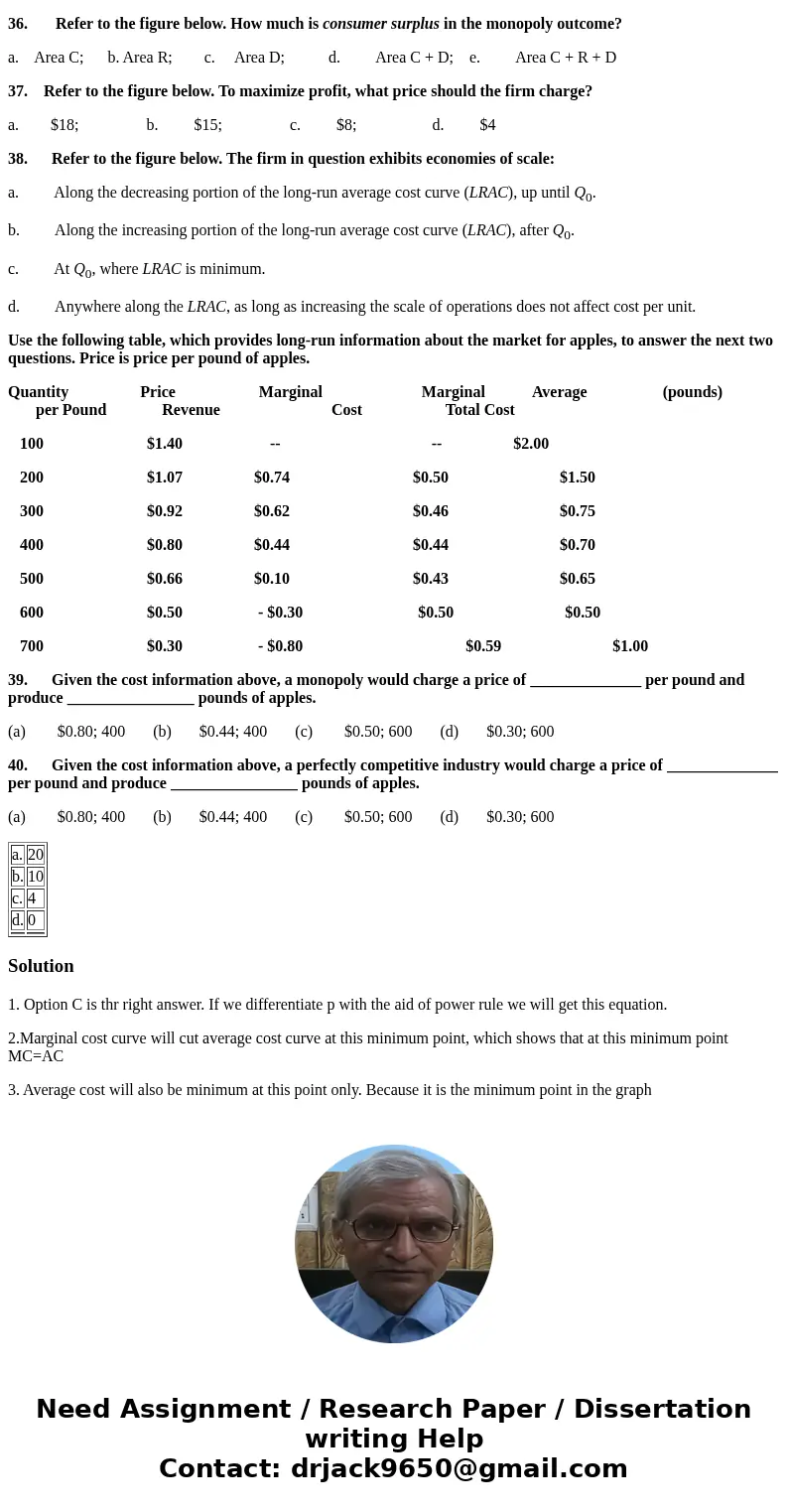
 Homework Sourse
Homework Sourse